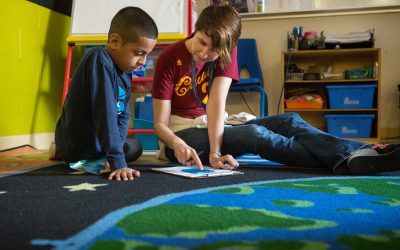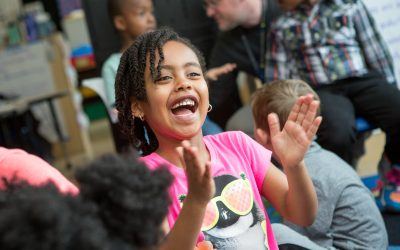Reflections on pedagogy that works for marginalized students, written by Jon Altbergs.
More than 15 years ago, Mike Schmoker’s “The ‘Crayola Curriculum’” appeared in Education Week.
In it, Schmoker laments the loss of opportunity in classrooms where students—especially those who are behind grade-level or from poverty-stricken homes and neighborhoods—were spending their time coloring, rather than reading and writing. As he observed classroom after classroom (more than 300 by his count) of students who could not read and in many cases did not even know the alphabet, he asked “Why wouldn’t they be learning the alphabet? Why are they coloring instead of being taught to read?”
-
Misconceptions about multiple intelligences and what it means to provide multi-modal opportunities for learning and expression.
-
The desire to engage students with ‘hands on’ activities.
-
Assumptions about class and race and the abilities of students from certain neighborhoods or ZIP codes.
Time is our most valuable resource—when it is spent poorly, we can’t get it back and we can’t ask for more. When students spend hours drawing and coloring, rather than reading, writing, and problem-solving, we’ve squandered time that could have been spent practicing and applying #CollegeReady skills.Time is our most valuable resource—when it is spent poorly, we can’t get it back and we can’t ask for more. When students spend hours drawing and coloring, rather than reading, writing, and problem-solving, we’ve squandered time that could have been spent practicing and applying #CollegeReady skills.
Fifteen years out and, sadly, we still see elements of the Crayola Curriculum in schools. Walk through many schools and you’ll see the evidence hanging on classroom walls and displayed in hallways. I won’t rehash Schmoker’s polemic—I encourage you to read it for yourself and, if you can, to read Results Now, especially Chapter 7, in which he decries the “The Startling State of Literacy Education” and what he terms “literature-based arts and crafts.”
What does a drawing of a medieval executioner wielding an ax over a chopping block really reveal about how well students understand the Eighth Amendment and the Bill of Rights?
Should we throw away the crayons, markers, and colored pencils in our classrooms? …I don’t think so.
I’ve always been a believer in the magic that happens between the hand and the brain. Taking notes, writing, and even doodling help us think and make meaning. New research suggests that drawing may actually enhance recall of information. We should take advantage, leveraging that power to engage students and tap into that magic, particularly at this moment in history, when information, ideas and feeling are all communicated in increasingly visual formats.
The six activities below—drawn from reDesign’s collection of more than 200 activities—just that by using drawing as a means for providing students opportunities to make meaning and deepen their learning.
If you can’t write about it, can you draw it out?
When you use these activities in your classroom, you’ll be amazed at what students can create if you keep the emphasis on the meaning-making work that they are undertaking. Remind students that you are not specifically assessing their artistic ability. Let them know you are asking them to use drawing as a way to deepen their understanding of ideas. Ultimately, the drawing is a way for them to think about these ideas from a new perspective.
Sketch to Sketch: Adapted from Michelle Kelley’s Comprehension Shouldn’t Be Silent, this activity asks students to draw an image from a text the teacher reads aloud, rather than taking traditional notes. Drawing while listening is a great way to help information stick, so this activity boosts listening comprehension and allows students to practice visualizing and summarizing.Draw to Remember Summaries
This activity is a great option for students who are reluctant writers, as it uses drawing as a point of entry to summarizing a text. Students first draw what they recall from the text, then write brief summaries to accompany the drawings. Rather telling students ‘summarize what you read’, you can use this activity to invite students to ‘draw what you remember’ then ask them to ‘tell us about what’s in your drawing.’
Draw-Label-Caption: Bringing together close reading and drawing, students draw, then choose key details from the text to label their drawing. This activity can be adapted for use across a variety of content areas, but when using it with nonfiction texts, avoid asking students to simply reproduce graphics from the text.
Open Mind: In this activity students infer the thoughts or feelings of a character in a fiction or nonfiction text, then represent those thoughts or feelings with symbols, words, or drawings. Be sure to follow up with a chance for students to share the thinking behind their chosen representation, either through a discussion or in writing. Open Mind works well as a quick think-pair-share activity for transition between activities or as synthesis at the end of a lesson.

Visual Timeline: Visual Timelines are a great tool for students to use while identifying a story arc or character development, for tracking specific events over the course of time, or describing a process. This one requires no artistic talent at all, as students can use images they find on the web to create their timelines or use ReadWriteThink’s free online tool, Timeline.
Storyboard Your Visualizations: I especially love this activity because it asks students to think more broadly about visualization–that our imagination isn’t just another eye, but a powerful tool that can engage all of our senses. It is especially effective for helping students recognize how an author evokes a sense of place in a novel or poem, or for helping them step into different geographical or historical locations.
Free online tools to use with these activities
Sketchpad: Draw, edit images, add text in your browser window, for free and without downloading any additional software.
Draw.io: A powerful free tool for creating diagrams, flowcharts, mind maps, and other graphic representations of information. If your school uses Google Classroom, you’ll definitely want to check this one out, as it integrates with Google Docs.
Mindmup: A simple, but not simplistic, tool for creating mind maps. Students can get started right away and share or save their creations in a variety of formats.
Join the community!
Sign up to receive our newsletter, access best-of educational resources, and stay in the know on upcoming events and learning opportunities. We hope to see you soon!




